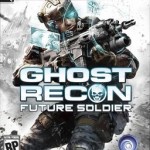 The rather clumsily titled “Tom Clancy’s Ghost Recon: Future Soldier” has no easy acronym like the previous games did. The earlier games in the series have been shortened by players, press and even the developers from “Tom Clancy’s Ghost Recon Advanced Warfighter” to the much more manageable “GRAW”, and its an appropriate acronym. If you were to use the word Graw in common language, it might be either a noise you would make when faced with extreme consternation, or an appreciative utterance of impressed surprise. For example:
The rather clumsily titled “Tom Clancy’s Ghost Recon: Future Soldier” has no easy acronym like the previous games did. The earlier games in the series have been shortened by players, press and even the developers from “Tom Clancy’s Ghost Recon Advanced Warfighter” to the much more manageable “GRAW”, and its an appropriate acronym. If you were to use the word Graw in common language, it might be either a noise you would make when faced with extreme consternation, or an appreciative utterance of impressed surprise. For example:
*Angrily*
“Graaawwww! This game starts just like a Modern Warfare Clone!”
*Surprised*
“Graw?!? That was really cool and unexpected and much more original than I expected!”
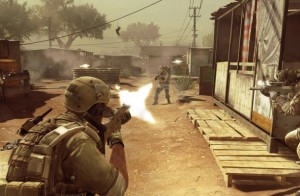 Yes? No? Well contrived openings aside, GRFS is a heady mix of inspirations both old and new and the resulting game is genuinely interesting if not exactly perfect. Its a mixed bag, and that bag has far more delicious caramel chews than disgusting raisins. I wasn’t sure what to expect having only played the previous games in the series briefly, but I was pleasantly surprised by a game full of neat gadgets, solid gameplay, innovative combat systems, streamlined squad tactics and well directed action scenes. The only problems are a few technical issues, ugly facial animations and an uninspired storyline.
Yes? No? Well contrived openings aside, GRFS is a heady mix of inspirations both old and new and the resulting game is genuinely interesting if not exactly perfect. Its a mixed bag, and that bag has far more delicious caramel chews than disgusting raisins. I wasn’t sure what to expect having only played the previous games in the series briefly, but I was pleasantly surprised by a game full of neat gadgets, solid gameplay, innovative combat systems, streamlined squad tactics and well directed action scenes. The only problems are a few technical issues, ugly facial animations and an uninspired storyline.
The Ghost Recon games are third person tactical shooters. To me they feel a lot like a 3rd person version of the Rainbow Six Vegas games which are FPS’s. Mechanically they are similar, with a focus on squad tactics, the use of cover, cool gadgets and weapon customisation. These are not games where you feel like Rambo or James Bond; instead you are a professional soldier with a mission to complete. That mission is accomplished through slow cautious progress, careful consideration of the battlefield, recon to obtain information on enemy movements and locations and teamwork. There’s one further key component in GRFS, and that’s the application of cutting edge technology to complete your mission and take out your targets. This game takes place in the near future and its not shy about dropping some seriously impressive technical hardware into your eagerly waiting hands. All of the technology is based on current developments that are all feasible and Tom Clancy’s attached name ensures a degree of credibility surrounds the gadgets and toys that may not be available today, but will be soon.
 Its telling that when you begin the game the top menu option is multiplayer with the singleplayer campaign second in line. You would expect this in MW3 or BF3, and you wonder if that is the arena that Ubisoft want GRFS to compete in.
Its telling that when you begin the game the top menu option is multiplayer with the singleplayer campaign second in line. You would expect this in MW3 or BF3, and you wonder if that is the arena that Ubisoft want GRFS to compete in.
Starting the campaign is initially a dispiriting experience. In much the same way as BF3’s singelplayer campaign was a terrible facsimile of an Infinity Ward game, GRFS similarly hits the same story beats and attempts to shock you with all the same tricks you’ve seen a hundred times before. Bomb stolen by terrorist something something…..Russians are the bad guys but they’re not something something…… main player character gets killed for dramatic effect something something. It manages to be both boring and frustrating at the same time. There’s not a single trope of a modern military game that it doesn’t copy shamelessly from other titles. Worst of all, it shares all the same issues as those other games with a storyline that manages to be both wafer thin and hard to follow. Computerised maps zoom in and out while serious American voices state “shit just got serious”. In truth, from mission to mission you will have no idea what your characters name is far less where you are or why you are there. I managed to survive these sections of the game because of my strange fascination with the characters malformed faces. To match the fact that the dialogue would never be said by a human, none of these characters really look like humans either.
With the diabolical story set out before me, I was prepared for weapons-grade disappointment, but things pick up very fast once the game actually begins.
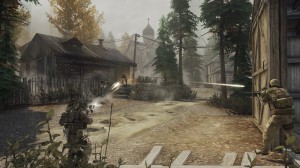 You play through the game as part of a four man squad and rarely face missions with less than three team mates. I was surprised early on to realise that in this squad you are not even the leader. You won’t be swapping between different characters or even telling your team-mates where to go. Instead you are part of a team and as such, your team leader will guide you through each level. One of the best aspects of this approach is that I was never unsure of where to go or what to do. The levels always feel expansive and open, but the line that you follow through with your squad helps streamline the whole experience. I honestly can’t think of an FPS where I got lost less. A combination of clever level design and tight scripting means that the game has a real feeling of forward momentum. This inertia pushes you through the campaign and means you seldom feel like taking a break. One more level, one more level, one more level, 4AM!
You play through the game as part of a four man squad and rarely face missions with less than three team mates. I was surprised early on to realise that in this squad you are not even the leader. You won’t be swapping between different characters or even telling your team-mates where to go. Instead you are part of a team and as such, your team leader will guide you through each level. One of the best aspects of this approach is that I was never unsure of where to go or what to do. The levels always feel expansive and open, but the line that you follow through with your squad helps streamline the whole experience. I honestly can’t think of an FPS where I got lost less. A combination of clever level design and tight scripting means that the game has a real feeling of forward momentum. This inertia pushes you through the campaign and means you seldom feel like taking a break. One more level, one more level, one more level, 4AM!
The actual combat is roughly divided into two forms: sneaky stealth combat and…. less sneaky combat. In the first instance you may be told that you must get through an area without raising an alarm. In the latter you can still use stealth to your advantage but at some point you will probably trip an alarm. Even when you do generally you will continue to fight and clear out the enemies you face. Unlike other less tactical games, GRFS doesn’t delight in sending waves of respawning enemies at you. While many modern military titles want to push you forward, GRFS rewards you for hanging back, picking a good spot and killing all the enemies you face with a combination of patience and care. Don’t get me wrong, boldly flanking enemies and taking them out works well too, but it doesn’t feel like the game is scripting it to work for you, or forcing you down a predefined path.
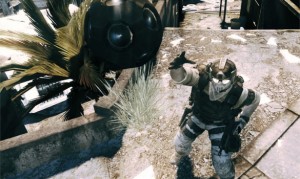 Combat is quick and brutal. You can be killed very easily especially when you are out of cover. If you take a few shots sometimes a team mate will come and revive you, but if you fail to spot an enemy with an RPG or a grenade falls at your feet you will be instantly killed. This seems tough but fair. The enemies in GRFS are just as lethal as you are. You defeat them not because you can soak up more bullets, but because you have outsmarted and outmanoeuvred them.
Combat is quick and brutal. You can be killed very easily especially when you are out of cover. If you take a few shots sometimes a team mate will come and revive you, but if you fail to spot an enemy with an RPG or a grenade falls at your feet you will be instantly killed. This seems tough but fair. The enemies in GRFS are just as lethal as you are. You defeat them not because you can soak up more bullets, but because you have outsmarted and outmanoeuvred them.
The use of cover is both essential and innovative. While in cover, if you look around you will see a circular outline on the ground in other safe areas close to you. By holding down the run button, you will automatically run to whichever of these safe areas you are looking at. This seems like a strange on-rails approach, but its actually a great idea. The visual effect resembles Gears of Wars roadie run, and by using this approach you can zigzag from cover to cover and get close to your enemies. The only issue here is that often the areas of cover that you have picked out for you aren’t ideal. Sometimes you will find yourself crouching on the WRONG SIDE of cover, sitting squat while your enemies massacre you with a torrent of bullets. Still, it works most of the time and I hope they stick with it and revise it for the next game in the series.
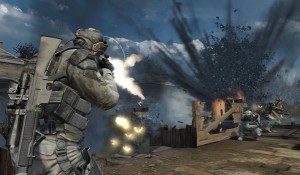 As well as the innovative movement system in GRFS there are a huge variety of toys for you to play with. By far the most important of these are the active camo system and the UAV drone. With the active camo you are almost invisible, and you have this for most of the game. By crouching you achieve a Predator-level camouflage effect. It won’t hide you from enemies who spot you up close and in the open, but generally it is good enough to allow you to travel all around the battlefield and explore your surroundings before committing on a plan of action. The UAV meanwhile is revelatory. A little flying drone that launches and lands on your outstretched hand, this little fellow let you scope out the whole area. Crucially, the UAV drone can mark targets for sync shots.
As well as the innovative movement system in GRFS there are a huge variety of toys for you to play with. By far the most important of these are the active camo system and the UAV drone. With the active camo you are almost invisible, and you have this for most of the game. By crouching you achieve a Predator-level camouflage effect. It won’t hide you from enemies who spot you up close and in the open, but generally it is good enough to allow you to travel all around the battlefield and explore your surroundings before committing on a plan of action. The UAV meanwhile is revelatory. A little flying drone that launches and lands on your outstretched hand, this little fellow let you scope out the whole area. Crucially, the UAV drone can mark targets for sync shots.
What are sync shots? Oh man! You can mark up to four targets for a sync shot. As long as you can see a target, you can mark them. Once you have four targets marked, each of your team mates will move into position to shoot at the target they are assigned. As they fourth member, you need to line up one of the shots yourself. Once all of the shots are lined up, you get a ready signal. As soon as you shoot, all three team mates will do so as well. Your reward is a slow motion kill sequence and a major release of dopamine in your brain. Seriously, there are few games experiences quite so satisfying as lining up and executing a four shot sync kill.
Brilliantly though, you can perform a sync kill with your three other team members without shooting yourself. In fact when moving through the stealth levels one of the easiest ways to achieve a 100% accuracy is to get your team mates to kill everyone for you. Acting as a spotter in this way is great fun, you feel like a reconnaissance scout, sneaking through long grass in your camo gear and marking targets for your team.
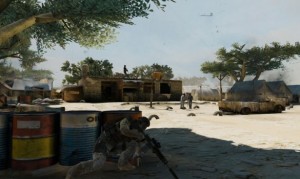 As I said above, you can also mark targets from the UAV drone. At times I cleared out whole areas with this technique. The game became more like a top-down squad shooter as I viewed the battlefield from above with my drone and ordered my squad mates to take out whole platoons of enemies. It all feels a bit like those parts of Assassins Creed Brotherhood where you call in your assassins to kill enemies for you. It feels a bit like cheating, and its gleeful, cheeky fun.
As I said above, you can also mark targets from the UAV drone. At times I cleared out whole areas with this technique. The game became more like a top-down squad shooter as I viewed the battlefield from above with my drone and ordered my squad mates to take out whole platoons of enemies. It all feels a bit like those parts of Assassins Creed Brotherhood where you call in your assassins to kill enemies for you. It feels a bit like cheating, and its gleeful, cheeky fun.
Some of the other gadgets are almost as great as the UAV, and its always the gadgets that sound the most dull. While grenades and flash-bangs are a little uninspiring, the humble sensor probe is great. A grenade that broadcasts enemy position wherever it is thrown, it shows enemies even when they are behind cover. Once you can see an enemy outlined in red through a wall, the satisfaction of firing a high calibre rifle round through that wall (and through the guys head) is immense. A few of the other gadgets are less fun though. A later level in snowy Russia sees you command a walking robot reminiscent of similar robots from MGS2. In this section you face huge numbers of enemies and wipe them out with mortars and missiles. Its fun at first but this section goes on too long and you begin to miss the purity and simplicity of stealth kills.
 While the game has moments where it looks great, there’s a definite roppiness about the visuals from time to time. Interiors can look a bit last gen and detail is generally quite low. Graphic glitches are common too, and at one point the whole floor of a level became transparent for me. Despite the occasional low detail levels the game has a very strong aesthetic based on heavy filters. From the snowy fields in Russia to the glare of the Pakistan sun, the lighting and effects throughout are brilliant. Added to this the game has a layer of AR over everything. This means that computerised text gets layered on to parts of the environment, macro blocking occurs when EMP grenades go off and all sorts of distortion and camera effects are used. From rain running down your visor to the cool magnetic and heat goggles, this is a game with a striking array of visual filters.
While the game has moments where it looks great, there’s a definite roppiness about the visuals from time to time. Interiors can look a bit last gen and detail is generally quite low. Graphic glitches are common too, and at one point the whole floor of a level became transparent for me. Despite the occasional low detail levels the game has a very strong aesthetic based on heavy filters. From the snowy fields in Russia to the glare of the Pakistan sun, the lighting and effects throughout are brilliant. Added to this the game has a layer of AR over everything. This means that computerised text gets layered on to parts of the environment, macro blocking occurs when EMP grenades go off and all sorts of distortion and camera effects are used. From rain running down your visor to the cool magnetic and heat goggles, this is a game with a striking array of visual filters.
Outside of the campaign the multiplayer is surprising engaging. Its slow paced compared with something like MW3 but still absolutely brutal. The gameplay modes are fairly standard with capture and hold variants and a deliver-the-bomb-type mode. Its fun at the moment, but already the proliferation of unlockable gadgets were making it hard for me to progress until I started unlocking some of these for myself too. Once I did there were large numbers of new players who struggled to kill me. Its perhaps down to players adjusting to the slower pace as much as the unlockable weapons, but I’m not sure the multiplayer mode will be as much fun in two weeks time once the veterans are fully equipped. I can’t speak to game balance right now, but I have a feeling this might be one area where the game will suffer. Time may prove me wrong.
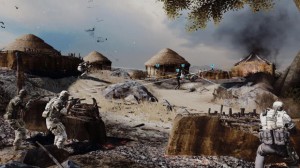 There’s a horde mode too called Guerrilla. Although fun, this mode seemed a little limited with a small number of levels to tackle. You can also only play with people on your friends list. This is the same for the main campaign. I was unable to find people to play with despite the fact that both Guerilla mode and the campaign seem ideally suited to group play. Playing with strangers online is often problematic, but its nice to have the option and at times the people I have met online in such cases have been far better teammates than those on my friends list anyway.
There’s a horde mode too called Guerrilla. Although fun, this mode seemed a little limited with a small number of levels to tackle. You can also only play with people on your friends list. This is the same for the main campaign. I was unable to find people to play with despite the fact that both Guerilla mode and the campaign seem ideally suited to group play. Playing with strangers online is often problematic, but its nice to have the option and at times the people I have met online in such cases have been far better teammates than those on my friends list anyway.
Overall GRFS is in interesting game that does enough differently to make it worth your while. The story is drivel, and the nods it makes to the Modern Warfare series are almost ruinous. One scene of a terrorist attack in particular is so terribly presented and tasteless that it almost put me off the whole experience. Lifted almost scene for scene from MW3’s terrorist attack scene in London, its shamefully derivative and artistically bankrupt. Despite these low moments, it seems that whoever wrote the awful story and cut scenes had nothing to do with the brilliant level design and gameplay. Tom Clancy’s Ghost Recon: Future Soldier is fun from beginning to end. As a fan of the Rainbow Six Vegas games, its great to see a third person shooter that also emphasizes great design, tactical combat and player emancipation over tightly scripted set pieces and on rails shooting galleries. Its hard to make a modern military shooter that gets your blood pumping, but Ubisoft Red Storm have managed to do just that. Gear up soldier!
8 sync kills performed perfectly out of 10
